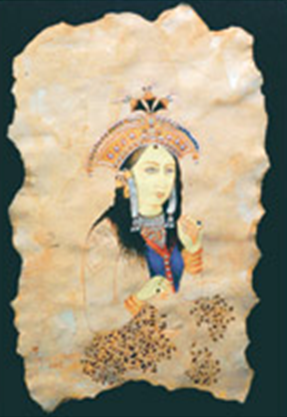Syed Najam ul Hassan Kazmi
This is a collection of articles archived for the excellence of their content. Readers will be able to edit existing articles and post new articles directly |
Syed Najam ul Hassan Kazmi
Capturing traditional aura
By Nadeem Zaidi
The exhibition of miniature paintings by renowned artist Syed Najam ul Hassan Kazmi held here at the Nomad Art Gallery in Islamabad showcased a rich and vibrant blend of traditional and contemporary aura of miniature.
Preserving the old traditional heritage of Central and South Asia, each of Kazmi’s 55 paintings displayed has a different story to tell. He has used the vasli in an experimental way. His brushstrokes are intricate and he has handsomely used blues and reds in most of his paintings along with stones and crystals for accentuation.
Viewing the paintings one witnesses a vibrant portrayal of the Mughal era in all its glory. From women bathing, talking, singing, dancing, reading, musicians playing music, to the famous Mughal ‘Darbar and Darbari’, the courtesans and also the hunters of the Mughal era, nothing has escaped Kazmi’s aesthetic canvas as he attempts to capture life as it was during the reign of the great Mughals.
In his work, Kazmi has managed to engage his creative energies in developing an active relationship with the forms that refer to earlier visual traditions. He has sought to develop a form that can simultaneously be about the past and the present, resisting the global trends toward uniformity of expression to create a personal vision that is culturally rooted.
Kazmi’s works take one in a flight of the traditional style of miniature painting with minute details of brushwork combined with contemporary techniques. Talking about his current works he explains that he has used simple Tea Technique on handmade paper (washed with tea). With watercolour, acrylic, natural leave colour, gold, needlework, and splashes of intricate Swarovski crystal and other gems, he uses a brush that he has made from a cat’s tail. Through his own creative exploration, he has discovered the subtlest touch of this cat’s tail brush for a more refined stroke.
As an artist dedicated to his work, Kazmi says his aim is to uphold the glorious heritage of the past, adding, “We are the inheritors of one of the most vibrant and affluent cultural heritages. We need to focus on our culture and make an effort to preserve its magnificence.”
Born in picturesque Skardu, Baltistan, Kazmi has won many awards and distinctions over the years including the Tamgha-e-Imtiaz in recognition of his exquisite miniatures in the traditional style. Having obtained his B.A. in Fine Arts from Kashmir followed by tutelage from ‘ustads’ and interactive learning from the masters he met during his visits to Iran and Kashmir, he is committed to the preservation of the Kashmiri heritage and handicrafts and is an expert in the techniques of Paper Mache. He represented Pakistan in several forums, including the OIC conference at Ispahan, Iran. He was awarded the seal of excellence for his innovative craftsmanship in Papier Masche handicrafts 2008 by UNESCO South Asian programme.
He has participated in group exhibitions of miniature painting and Paper Mache crafts held in Germany, France, Iran, India, Gulf, Great Britain and Pakistan.
In Kazmi’s work one witnesses a vibrant portrayal of the Mughal era in all its glory

